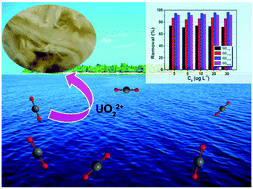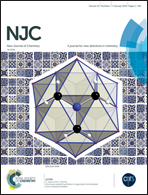Efficient removal of uranium(vi) from simulated seawater with hyperbranched polyethylenimine (HPEI)-functionalized polyacrylonitrile fibers†
Abstract
Capturing uranium(VI) from seawater is of paramount interest for the rapid expansion of energy needs. We report on materials covalently functionalized with amine groups to improve gas adsorption and remove metal ions. In this paper, polyacrylonitrile fibers (PANFs) covalently modified with hyperbranched polyethylenimine (HPEI) of different grafting degrees were facilely synthesized, and their performance to capture U(VI) in the presence of competitive ions and simulated seawater evaluated. In addition, the adsorption properties of the as-prepared adsorbents, including thermodynamics, kinetics and the influence of critical factors affecting U(VI) adsorption from aqueous solution were examined. The fibers with the best performance were characterized by X-ray photoelectron spectroscopy, scanning electron microscopy and Fourier transformed infrared spectroscopy. The high density of amine groups on the modified fiber surface improves the adsorption ability by electrostatic attraction and surface interaction during the reaction process. From our findings, PAN–HPEI offers wide-ranging potential in the wide field of the removal of metal ions, and, in particular, the removal of U(VI) from seawater with high throughput.



 Please wait while we load your content...
Please wait while we load your content...